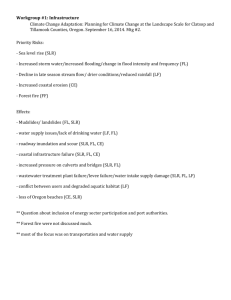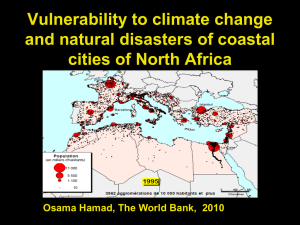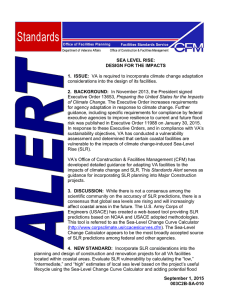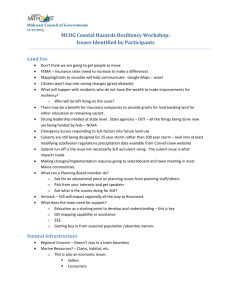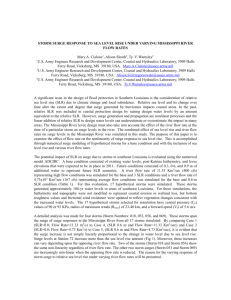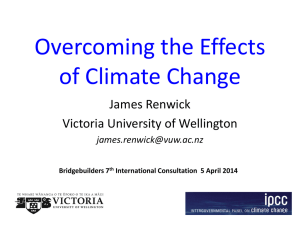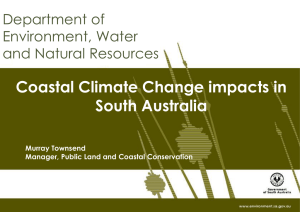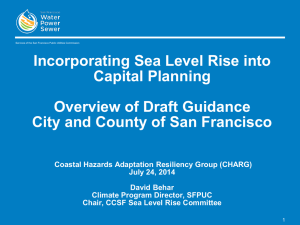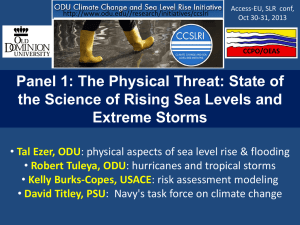Online Resource 1 Joint Effects of Storm Surge and Sea
advertisement
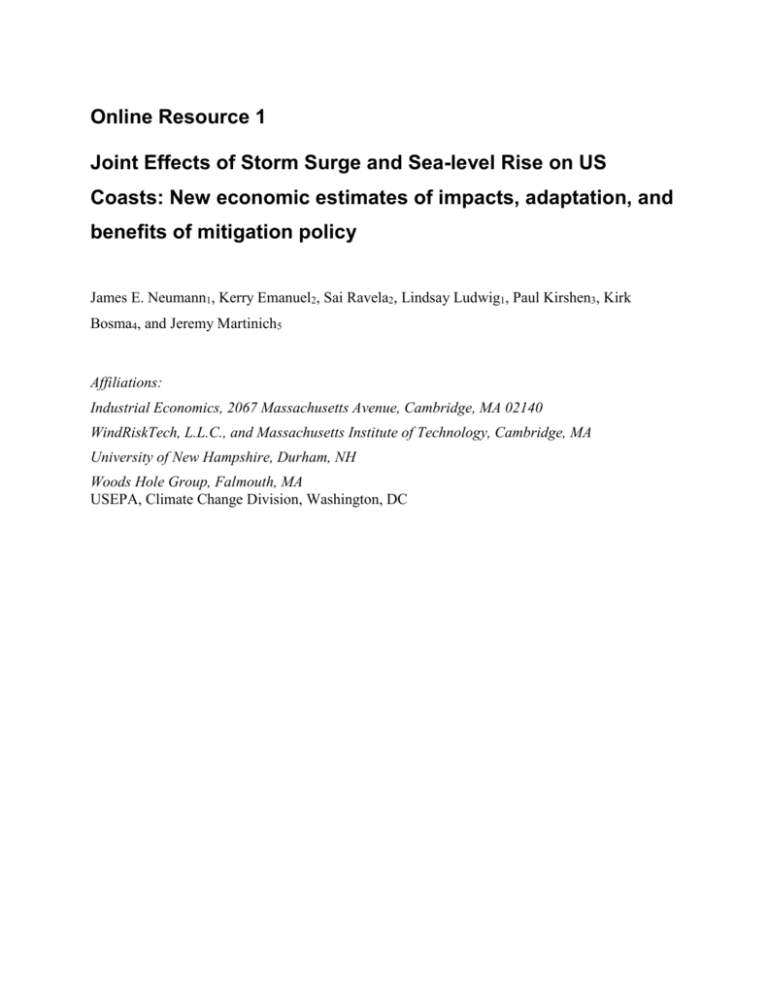
Online Resource 1
Joint Effects of Storm Surge and Sea-level Rise on US
Coasts: New economic estimates of impacts, adaptation, and
benefits of mitigation policy
James E. Neumann1, Kerry Emanuel2, Sai Ravela2, Lindsay Ludwig1, Paul Kirshen3, Kirk
Bosma4, and Jeremy Martinich5
Affiliations:
Industrial Economics, 2067 Massachusetts Avenue, Cambridge, MA 02140
WindRiskTech, L.L.C., and Massachusetts Institute of Technology, Cambridge, MA
University of New Hampshire, Durham, NH
Woods Hole Group, Falmouth, MA
USEPA, Climate Change Division, Washington, DC
Fig. 1 Sea-level rise with dynamic ice sheet melting
Fig. 2 Cumulative total costs of adaptation by 2100 in the contiguous US for sea-level rise with
dynamic ice sheet melting, discounted at 3% ($ million)
Fig. 3 Cumulative total costs of adaptation by 2100 for sea-level rise with dynamic ice sheet
melting and storm surge for the 17 modeled sites only, discounted at 3% ($ million)
Fig. 4 Total costs of adaptation by 2100 under reference 3o scenario with dynamic ice sheet melting, discounted at 3% ($ million)
Fig. 5 Comparison of cumulative total costs of adaptation by 2100 in the contiguous US for sealevel rise with dynamic ice sheet melting with and without storm surge, discounted at 3% ($
million)
Fig. 6 Cumulative benefits in the contiguous US for sea-level rise with dynamic ice sheet melting
with (dashed line) and without (solid line) storm surge, discounted at 3% ($ millions)
Additional Information on Climate Projections
Three emissions scenarios are used: a reference (REF) or business as usual scenario,
corresponding to a radiative forcing of 10.0 W/m2 by 2100, and two future scenarios that limit
global GHG emissions such that the global radiative forcing levels in 2100 are stabilized at 3.7
W/m2 (Policy 3.7) and 4.5 W/m2 (Policy 4.5). In addition, three alternative climate sensitivity
values are applied in the analyses of this paper: 2C, 3C and 6C.
Using these scenarios, future climate projections for projecting SLR effort were developed using
the National Center for Atmospheric Research’s Community Atmospheric Model (Version 3), a
three-dimensional atmosphere model, linked with the Integrated Global Systems Model (IGSMCAM) (Monier et al. 2013). As a full general circulation model (GCM), IGSM-CAM generates
projections that incorporate not only changes in mean climate, but also incorporates features
explicitly designed to allow for year-to-year variability. Decadal SLR projections (absent
dynamic ice-sheet melting) were a direct output of the IGSM model. As described in the text,
estimates that include dynamic ice sheet melting were derived from the empirical model of
Vermeer and Rahmstorf (2009) using average ambient air temperature trajectories from the
IGSM model. Storm surge estimates derive from hurricane modeling that simulates storm
generation activity over the 20st century using backcasting results from the GFDL Climate Model
for the historic period of 1956 to 2005.
Additional Methodological Details for EPA’s National Coastal
Property Model (NCPM)
The overall framework of the model is presented in Figure 1. The basic structure involves
arraying relevant input data, listed on the left side of Figure 1, and constructing a spatial
geodatabase on a 150-m grid cell frame, which can then be analyzed to estimate response to
SLR, the cost of the adaptive response, and the ‘residual damages’ that result in areas where
adaptive measures are not cost-effective, and therefore flooding damages are evident. The grid
frame encompasses virtually all areas potentially vulnerable to the effects of SLR and storm
surge, including approximately 300 coastal counties in the continental US. Most of these
counties have direct coastal or bay frontage, but some are affected only through proximity to
tidally influenced rivers and tributaries, a common geographic feature in the Southern Atlantic
and Gulf regions. Analysis and aggregation modules of the model, depicted in the center right
and bottom right corner of Figure 1, access the site-specific data within the geodatabase (e.g.,
elevation) along with a series of user-defined input parameters (e.g., SLR scenario and the cost
of armoring or beach nourishment), and estimate the timing and costs of adapting to SLR over
time. Armoring involves a hard structure of some sort—prior work and review suggests concrete
structures on ocean-fronting areas, and less expensive bulkheads on bay-fronting areas—and
beach nourishment involves placing sand on beach areas. In all cases, long-term maintenance of
structures or period re-nourishment is also required, with differential costs for each.
Some elements of the framework, particularly the optimal response model, rely extensively on
earlier research by Yohe et al. (1996 and 2011) assessing economic impacts for 30 coastal US
sites. The optimal response approach is based on a simplified benefit–cost analysis of protective
structures and beach nourishment relative to a retreat response. The planning problem expressed
as an optimization problem involves choosing a time between today and 2100 to initiate a
protection plan as adaptation to SLR which maximizes the following expression:
PV{B[t0,T]} − PV{C[t0,T]} (1)
where t0 is the time when protection as adaptation is initiated, T is the time when protection that
had been initiated subsequently might be abandoned, and the present value of B and C are
expressions of the benefits and costs, respectively, of protection over time as a function of the
choice of t0. Prior theoretical work established that if hard structure protection prior to 2100 is
optimal, then it remains optimal to continue to maintain that hard structure in perpetuity, making
the otherwise difficult estimation of T irrelevant. As a result, this generic model simplifies to the
following decision rules. First, where the cost of measures designed to protect properties from
SLR is less than the benefit of avoided property value loss, the time to begin protection that
maximizes Eq. (1) is earlier than 2100, and the adaptation cost incurred in response to SLR is
estimated as the capital cost of construction plus ongoing maintenance costs. Second, where the
estimated protection cost exceeds the benefit of adaptation, the expression is maximized when t0
is equal to the time horizon of the simulation, in this case 2100. Then retreat (i.e., abandonment)
is the estimated response to the threat, and the impact of SLR is lost structure and land value.
Projecting resources at risk involves, at minimum, estimating how real property values could
appreciate—our approach links future property value to a projection of US gross domestic
product (GDP) developed as part of a broader EPA project (see Neumann et al. 2014).
Implicit in our response analysis are two key features of the approach: (1) we estimate the
optimal timing of a response, largely based on the timing of inundation and (2) abandonment
decisions are irreversible, and protection and beach nourishment decisions, while theoretically
reversible, are also effectively permanent. Estimating optimal timing demands that we rely on an
SLR trajectory, rather than simply an endpoint, and also critically affects the economic cost
calculations through application of a positive discount rate. Irreversible decisions are not a
requirement of the approach, but prior work suggests that, at least within the optimal response
paradigm, these decisions are made once and remain robust over time.
References for Online Resource 1
Monier E, Gao X, Scott J, Sokolov A, Schlosser A (2013) A framework for modeling uncertainty
in regional climate change. Climatic Change
Neumann JE, Price J, Chinowsky P, Wright L, Ludwig L, Streeter R, Jones R, Smith JB, Perkins
W, Jantarasami L, and Martinich J. (2014) Climate change risks to US infrastructure: impacts
on roads, bridges, coastal development, and urban drainage. Climatic Change, DOI
10.1007/s10584-013-1037-4.
Vermeer M, Rahmstorf S (2009) Global sea level linked to global temperature. Proceedings of
the National Academy of Sciences 106(51): 21527-21532
Yohe, G, Neumann, JE, Marshall, P and Ameden, H. (1996) The Economic Cost of Greenhouse
Induced Sea Level Rise in the United States. Climatic Change. 32: 387-410.
Yohe, G, Knee, K, and Kirshen, P (2011) On the economics of coastal adaptation solutions in an
uncertain world, Climatic Change, 106:71–92.
